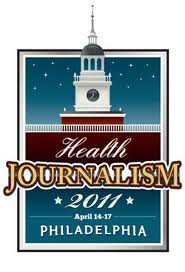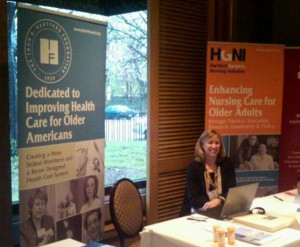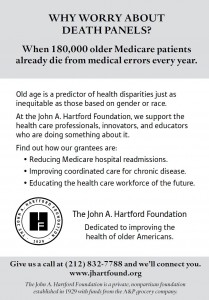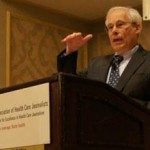 It felt different this year. For the second time, John A. Hartford Foundation staff and our communications partners, SCP, attended the annual conference of the Association of Health Care Journalists. We once again sponsored the meeting and exhibited materials from our grantees. We talked to reporters about the critical need for a better trained workforce and improved models of health care delivery for frail, vulnerable elders. But instead of having to push, prod, and explain, it felt like the issues we care about were at the top of the “newsworthy” list. With Medicare policy proposals currently pouring in and increasing recognition that controlling health care costs hinges on how we manage complex chronic conditions, end-of-life care, and long-term care – the journalists seemed to seek us out, hungry for information about our work.
It felt different this year. For the second time, John A. Hartford Foundation staff and our communications partners, SCP, attended the annual conference of the Association of Health Care Journalists. We once again sponsored the meeting and exhibited materials from our grantees. We talked to reporters about the critical need for a better trained workforce and improved models of health care delivery for frail, vulnerable elders. But instead of having to push, prod, and explain, it felt like the issues we care about were at the top of the “newsworthy” list. With Medicare policy proposals currently pouring in and increasing recognition that controlling health care costs hinges on how we manage complex chronic conditions, end-of-life care, and long-term care – the journalists seemed to seek us out, hungry for information about our work.

Luckily, they also got to hear first-hand from a few of our grantees and friends in the field. Mary Naylor spoke on a panel about the Transitional Care Model and its potential to reduce hospital re-admissions, along with Dorie Seavey of PHI, Kathleen Kelly from the Family Caregiver Alliance, and Emily Saltz of Elder Resources.
Christine Arenson, a geriatrics division director and participant in the Foundation-funded ADGAP Leadership Development Program spoke to journalists about interprofessional training at Thomas Jefferson University on a panel called “Educating the 21st Century Doctor.” While the concept of team training has been around a while (see our GITT program), she noted that “this time feels different,” with new efforts to hold providers accountable for quality and safety. We were told to look soon for interprofessional education competencies being developed right now by the AACN, AAMC, and others.
 Rebecca Sudore, a geriatrician and palliative care physician at UCSF where we have a Center of Excellence in Geriatric Medicine, presented about end-of-life decision making. The “death panel” debates of last year were both a set-back and an opportunity to talk about advanced care planning and the potential for over-treatment at the expense of quality of life. Our own Amy Berman has eloquently blogged about this issue. (We used “death panels” to grab attention with our ad in the conference program – see right).
Rebecca Sudore, a geriatrician and palliative care physician at UCSF where we have a Center of Excellence in Geriatric Medicine, presented about end-of-life decision making. The “death panel” debates of last year were both a set-back and an opportunity to talk about advanced care planning and the potential for over-treatment at the expense of quality of life. Our own Amy Berman has eloquently blogged about this issue. (We used “death panels” to grab attention with our ad in the conference program – see right).

Headliners like Don Berwick, director of the Centers of Medicare and Medicaid Services, and Francis Collins of the National Institutes of Health, also spoke. Dr. Berwick reiterated his position that health care costs can be controlled by either cutting services or improving them, and that the latter is the right answer. He touted the recently announced $500 million Community Based Care Transitions program modeled on the work of Dr. Naylor and Eric Coleman, another Foundation grantee. For the data-hungry journalists in the room, he introduced the Health Indicators Warehouse, a multi-agency web repository launched in February that gives population health measures. He and Dr. Collins both spoke of greater transparency and better coordination between federal offices. I’m sure the reporters in the room will help keep them to their word.
While the receptivity and focus on issues specific to the care of older adults felt stronger this year, some things about the health care journalists did not change. They continued to impress me with their detailed knowledge of the field, their intense desire to inform and educate their audience, and their acceptance of responsibility in helping facilitate the debate about health care in this country. And of course, being journalists, every session ended with a very, very long line of questioners.
We were joined in sponsorship of the conference by several other foundations, including the Robert Wood Johnson Foundation, The Commonwealth Fund, California HealthCare Foundation, New York State Health Foundation, and the Northwest Health Foundation – all doing good work from their own angles. I hope our Foundation provided – and will continue to provide – access to our grantees and useful information for journalists as they report on health care, bringing older adults and geriatric care to the headlines.
Several of the conference’s award winning journalists focused on aging issues. Links to their articles can be found here:
General Interest Magazines above 1 million circ. - First Place: My Father's Broken Heart; Katy Butler, The New York Times Magazine
General Interest Magazines below 1 million circ. - Second Place: End of Life: Lessons of a $618,616 Death; Amanda Bennett, Bloomberg Businessweek
Beat Reporting - First Place: Kay Lazar's 2010 Body of Work; Kay Lazar, The Boston Globe
Metro Newspapers - First Place: Seniors for Sale; Michael J. Berens, The Seattle Times
